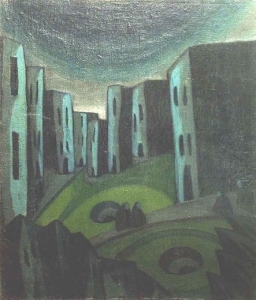by Cathy Dobson for the Sarnia Observer
(2012) The next time a national tour is mounted featuring the work of Sarnia’s own Lowrie Warrener, it might actually stop in Sarnia.
That wasn’t the case in 2010 when Gallery Lambton loaned several of its Warrener pieces to a national exhibition and was told the public gallery in the Bayside Mall wasn’t up to snuff.
With a leaky roof, unreliable temperature controls and insect nests in the storage room where the permanent art collection was housed, Gallery Lambton wasn’t good enough to host a tour of that caliber.
That’s one of the reasons there was such a strong push to build the new Judith and Norman Alix Art Gallery, preparing for its grand opening Oct. 5.
It will be a “Category A” gallery, built to a standard that encourages private art collectors to donate work and satisfy the concerns of other galleries lending their paintings. The new gallery will also have much more space to exhibit the permanent collection owned by Lambton County and today mostly stored behind closed doors at the old gallery.
The permanent collection includes 10 Lowrie Warrener paintings, two of his woodblocks, a pencil sketch and a number of his Christmas cards.
Warrener was born in Sarnia in 1900 and, the story goes, was inspired to start painting when he met Arthur Lismer at a 1920 exhibition hosted by the Sarnia Women’s Conservation Committee at the Sarnia Carnegie Library. His exposure to the brilliant colour and rugged style Tom Thomson and the Group of Seven introduced to the Canadian art scene greatly influenced Warrener’s style.
He left for Toronto’s Ontario College of Art in 1921 to study sculpting and learned to paint.
A generation of Sarnians became familiar with Warrener’s work when they walked into the library and saw “The Happy Cottage,” which hung in the children’s department for many years.
Warrener was commissioned by the Lambton Loan Company on Maria Street to do the painting. The loan company didn’t like it because he distorted the building, so The Happy Cottage was sold to the Women’s Conservation Committee.
In 1925, Warrener returned to Sarnia and started working on the lakers to finance sketching trips up north, which he would take with other emerging artists. The following year, Warrener had an exhibition of his own at the library and sold 25 paintings. It was considered a triumph. An untitled example of his work during that period will be on display when the new gallery opens to the public.
“We chose it because it looks like it could be done by one of the Group of Seven,” said curator Lisa Daniels. “Later, Warrener’s paintings became much more abstract.”
The gallery also owns “In a Monastery Garden,” painted by Warrener in 1929. It reflects what Warrener became,” Daniels said. “His later work was very abstract, with an earthy darkness and gloomy subjects.”
It also reflected the theatrical sets he built in Toronto where his work was considered avant guard.
Warrener was an important Canadian artist primarily because of his abstract work, though he produced little in his later years.
“You don’t see a lot of his work on the market,” Daniels said. “But he’s definitely important.”
Warrener’s “In a Monastery Garden” will be part of an intimate exhibition at the new gallery called Core Sample: Points of Departure, one of several opening exhibitions showing Oct. 5 – Feb. 3, 2012.


